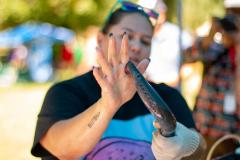
View original article here.
On a hot July day, Umatilla youth scrambled over the rocks at the base of Willamette Falls. There was thick moss, dry and scratchy like a Brillo pad, the smell of fish heavy in the air, and the sound of laughter carrying across the roar of the water as the kids harvested Pacific lamprey at the falls.
Umatilla tribal members said this was the biggest harvest in several years. That there even was a harvest underscored work the Umatilla and other tribes have led to restore the eel-like fish’s population. But there is still much to be done in the fight for lamprey to once again thrive in these waters, according to Corrine Sams, an elected member of the Umatilla board of trustees and vice chair of the board of commissioners for the Columbia River Intertribal Fish Commission.
Sams led the youth in song, honoring the lampreys’ gift of their lives, before the group began to search the base of the falls for pockets of lamprey to harvest.
"This work we’re doing, it’s not for us,” Sams told the group of children circled around her. “It’s for your grandchildren, your great-grandchildren.”

'Everybody is our relative'
Though Willamette Falls is not accessible to the general public, four tribes have treaty rights granting them access to subsistence and ceremonial harvest at the falls — Yakama Nation, the Confederated Tribes of the Umatilla Indian Reservation, the Confederated Tribes of Warm Springs and the Nez Perce Tribe. The Confederated Tribes of Grand Ronde also harvests lamprey and salmon at the falls, under an agreement with the state of Oregon.

“Historically, we came down here to harvest and trade but really just to be amongst the river people,” Sams said. “Everybody is our relative. Before treaties and lines were crossed, we were all Indigenous people who lived together and fished and gathered and celebrated.”
While Umatilla tribal members searched for lamprey on Thursday, hundreds of community members gathered at Clackamette Park.
In celebration of the harvest this year, and to honor the lamprey themselves, Yakama Nation hosted the second annual Willamette Falls Lamprey Celebration.

“I’m here today for the gathering and have been coming here since the 1960s, since I was a little boy going out on boats with my father and watching him gather the eels,” said Yakama elder Arnold Eyle, a member of the Yakama Nation Tribal Council.
A group of elder Yakama women were hard at work preparing lamprey to feed the crowd. Dressed in a flannel apron with her hair pulled back by a floral scarf, one of the women deftly sliced open each lamprey. She used the back of her thumb and a spoon to remove the guts before rinsing the fish and handing it off to be fileted and eventually barbecued.
“Why we’re here today is because we show the lamprey that we’re not forgetting them, we’re honoring them, and letting them know that we’re gonna take care of them,” said Yakama elder Terry Heemsah Sr., a Yakama Nation Tribal Councilman and Member of the Fish and Wildlife Committee.

A keystone species
Lamprey are an important first food for Pacific Northwest tribes, who have been harvesting at the falls since time immemorial.
Davey Lumley, a Yakama Nation pacific lamprey biologist, pulled a live lamprey out of a fish tank while educating onlookers about the eel-like fish.
“I’ve heard stories about how the population here used to be massive,” Lumley said, gesturing in the direction of the falls. “It used to cover the rocks, used to be known as ‘maiden’s hair’ because the lamprey was so thick, it looked like hair in the water.”
A keystone species, lamprey have been around for over 450 million years.
For the first three to seven years of their lives, pacific lamprey live in the sediment of creeks as filter feeders. Once mature, they become parasitic adults, migrating to the ocean to feed on bigger fish by latching on and using their pointed tongs to create a small hole to feed on the blood of the host fish — the host typically does not die. Ending their life cycle, lamprey return home to rivers and creek beds to spawn, attracted by the pheromones of other lamprey.
Though lamprey have long served as an important food source for local tribes, there has been a significant decline in lamprey populations. Some of the biggest threats to the species include dams and negative imagery about lamprey, according to Lumley.

“River Monsters did an episode where they actually came here, but they didn’t distinguish between our lamprey, the Pacific lamprey, and the sea lamprey,” Lumley said. “As a lamprey biologist enthusiast, it was unfortunate to watch that. So educational outreach is very important.”
Not only did Lumley’s booth at the celebration provide education about lamprey, she also talked about lamprey conservation efforts led by tribes.
In 2009, Yakama Nation began the Pacific Lamprey Project to aid in restoring Pacific lamprey population levels.
The project monitors lamprey population levels, runs a hatchery, performs habitat surveys and interviews tribal elders for historical background, among other things, according to Lumley.
Lamprey biologists like Lumley serve as a voice advocating for the lamprey.
The Columbia River Inter-Tribal Fish Commission, made up of the Nez Perce, Umatilla, Warm Springs and Yakama tribes, also leads lamprey restoration efforts.
The Commission, along with the Willamette Falls Trust, supported Yakama Nation in hosting this year’s lamprey feast and celebration.

Guided by traditional ecological knowledge, the fight to recognize the importance of lamprey for both ecosystem health and cultural significance has been an effort led by local tribes. Hopefully, increasing numbers of lamprey will continue to return to the falls.
“The work that we do and the words that we speak are borrowed from our ancestors and we pass that down generation to generation,” Sams said. “So today, the work that we’re doing, this celebration, this isn’t for us, it’s for those that are yet unborn.”
